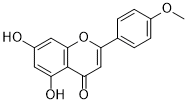Acacetin (5,7-Dihydroxy-4′-methoxyflavone)
This product is for research use only, not for human use. We do not sell to patients.

For small sizes, please check our retail website as below: www.invivochem.com
| Size | Price | Stock |
|---|---|---|
| 250mg | $400 | Check With Us |
| 500mg | $600 | Check With Us |
| 1g | $900 | Check With Us |
Cat #: V10036 CAS #: 480-44-4 Purity ≥ 99%
Description: Derived from Dendranthema morifolium, Acacetin is a novel and potent Flavonoid.
Top Publications Citing Invivochem Products
Publications Citing InvivoChem Products
Product Promise

- Physicochemical and Storage Information
- Protocol
- Related Biological Data
- Stock Solution Preparation
- Quality Control Documentation
| Molecular Weight (MW) | 284.26 |
|---|---|
| Molecular Formula | C16H12O5 |
| CAS No. | 480-44-4 |
| SMILES Code | O=C1C=C(C2=CC=C(OC)C=C2)OC3=C1C(O)=CC(O)=C3 |
| Synonyms | NSC 7606; Acacetin |
| Protocol | In Vitro | Acacetin (50-150 μM; 24 hours) leads to decreases in levels of PI3Kγ-p110, p-AKT, p-mTOR, p-p70S6K, and p-ULK in a dose-dependent manner. Acacetin (50-150 μM; 24 hours) causes G2/M cell cycle arrest and induces apoptosis and autophagy. Acacetin (5,7-Dihydroxy-4'-methoxyflavone; 10-200 μM; 24 hours) decreases cell viabilities in a dose-dependent manner. Acacetin has little effect on human normal glial cell line HEB and non-tumorigenic epithelial cell line MCF-10A. |
|---|---|---|
| In Vivo | Acacetin (5,7-Dihydroxy-4'-methoxyflavone; 5, 20 mg/kg/day; orally; for 3 days) significantly suppresses microglial activation in an LPS-induced neuroinflammation mouse model. |
These protocols are for reference only. InvivoChem does not
independently validate these methods.
| Solvent volume to be added | Mass (the weight of a compound) | |||
|---|---|---|---|---|
| Mother liquor concentration | 1mg | 5mg | 10mg | 20mg |
| 1mM | 3.5179 mL | 17.5895 mL | 35.1791 mL | 70.3581 mL |
| 5mM | 0.7036 mL | 3.5179 mL | 7.0358 mL | 14.0716 mL |
| 10mM | 0.3518 mL | 1.7590 mL | 3.5179 mL | 7.0358 mL |
| 20mM | 0.1759 mL | 0.8795 mL | 1.7590 mL | 3.5179 mL |
The molarity calculator equation
Mass(g) = Concentration(mol/L) × Volume(L) × Molecular Weight(g/mol)
Mass
=
Concentration
×
Volume
×
Molecular Weight*
The dilution calculator equation
Concentration(start)
×
Volume(start)
=
Concentration(final)
×
Volume(final)
This equation is commonly abbreviated as: C1 V1 = C2 V2
Concentration(start)
C1
×
Volume(start)
V1
=
Concentration(final)
C2
×
Volume(final)
V2
Step One: Enter information below
Dosage mg/kg
Average weight of animals g
Dosing volume per animal µL
Number of animals
Step Two: Enter the in vivo formulation
%DMSO
+
%
+
%Tween 80
+
%ddH2O
Calculation Results:
Working concentration:
mg/ml;
Method for preparing DMSO master liquid:
mg
drug pre-dissolved in
µL
DMSO(Master liquid concentration
mg/mL)
,Please contact us first if the concentration exceeds the DMSO solubility of the batch of drug.
Method for preparing in vivo formulation:
Take
µL
DMSO master liquid, next add
µL
PEG300, mix and clarify, next add
µL
Tween 80,mix and clarify, next add
µL
ddH2O,mix and clarify.
Note:
- (1) Please be sure that the solution is clear before the addition of next solvent. Dissolution methods like vortex, ultrasound or warming and heat may be used to aid dissolving.
- (2) Be sure to add the solvent(s) in order.




































